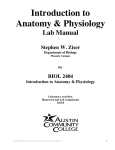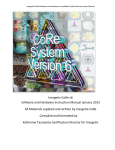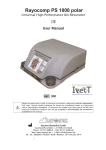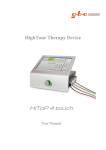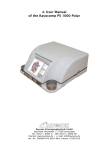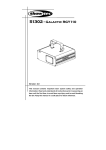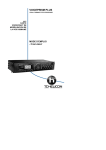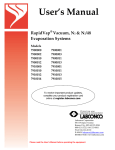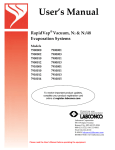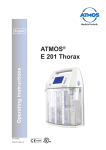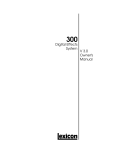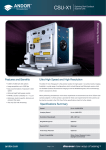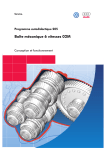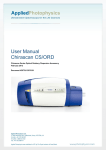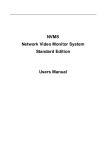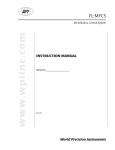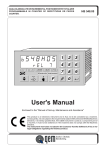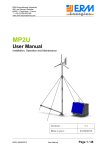Download Rayocomp PS 10
Transcript
Rayocomp PS 10 Portable High-Performance Bio-Resonator User Manual Art.-Nr.: 9100EN In spite of all the information, advice and suggestions for solving problems, this book cannot replace a visit to an alternative practitioner or a doctor orientated to natural healing. Also, we must point out that the classic orthodox medicine still does not accept or acknowledge the interrelations presented in this manual. 1. Contents Page 2 1. Contents 2 2. Conformity Declaration 4 3. Basics of the Rayocomp PS 10 5 3.1 Volume of Delivery 5 3.2 Technical Data 5 3.3 Safety Instructions as to Operation 6 3.4 Guarantee 6 3.5 Cleaning 6 3.6 Understanding the Device 7 3.6.1 3.6.2 3.6.3 3.6.4 Front View Rear View Keyboard Display 4. User Manual 4.1 General Directions for Operation 4.1.1 Literature Relating to the Bio-Resonance According to Paul Schmidt 4.1.2 Charging the Integrated Power Pack 4.1.3 Switching the Device On and Off 4.1.4 Selecting the Menu with the Mode Key 4.1.5 Operating the Integrated Polariser and Sensor 4.1.6 Basic Information for RAH ‘Green Card’ 4.1.7 Error Display 4.2 Menu Item “Direct“ 4.2.1 Testing and Harmonising a Fundamental Frequency Value with the Integrated Polariser and Sensor 4.2.2 Setting Up Individual Fundamental Frequency Values 4.2.3 Automatic programme sequence by using a RAH ‘ Green Card’ 4.3 Menu Item “F1“ 4.3.1 Basics Concerning the Use of Integrated Programs 4.3.2 Composing and Harmonising Various Harmonising Programs 4.3.3 Loading Fundamental Frequency Values from Memory Cards and Harmonising 4.3.4 Fundamental Frequency Values from the Menu Item “Test“ - Taking Over and Harmonising 4.3.5 Utilising the Harmonising Programs of the new RAH 7 8 9 10 11 11 11 12 13 14 18 20 21 22 22 23 24 25 25 26 29 29 30 1. Contents Page 3 4.4 Menu Item “Test“ 4.4.1 4.4.2 4.4.3 4.4.4 4.4.5 4.4.6 4.4.7 4.4.8 Testing Range Values Testing with Memory Card Values Testing with Integrated Programs Testing with Integrated Test Programs RAH-Module 10: Level test RAH Module 10: Test with integrated test protocols RAH Module 10: Test with the RAH ‘Green-Card’ Important tips and tricks for testing with the RAHModule 10 4.5 Menu Item “Setup“ 4.5.1 4.5.2 4.5.3 4.5.4 4.5.5 Set-Up of Background Illumination Deleting Double Values in the F1 Programs Adjusting the ‘Attention’ Sound (Beep) Pre-Setting the Test Range Values Presetting the harmonisation time for Fundamental Frequency Values 4.5.6 Activating and Deactivating Modules 4.5.7 Storing Fundamental Frequency Values on Memory Cards 4.5.8 Displaying Memory Card Information 4.5.9 Providing Read-Protection for a Memory Card 4.5.10 Providing Write-Protection for a Memory Card 4.5.11 Deleting a Memory Card Completely 4.5.12 Initialising a Memory Card 4.5.13 Motor Test Run of the Frequency Module 35 37 38 38 39 40 44 45 46 49 50 50 51 51 52 53 54 55 56 56 57 57 58 4.6 Menu Item “Info“ 59 4.7 Special Function Keys 61 4.7.1 Using the IF-Keys 4.7.2 Using the 10.0-Key 61 61 5. Appendix 5.1 5.2 5.3 5.4 5.5 5.7 5.8 Summary Summary Summary Summary Summary Summary Summary 62 of of of of of of of the the the the the the the Integrated Test Programs Integrated Rayonex Programs Integrated Acupuncture Programs Integrated Special Programs Integrated Programs by Dr. Ulrich Modules for Integration Possible Error Messages 6. Private Documents 62 63 64 65 66 67 68 70 2. Conformity Declaration Page 4 3. Basics of the Rayocomp PS 10 3. Page 5 Basics of the Rayocomp PS 10 3. 1 Volume of delivery The delivery volume consists of: 1. 2. 3. 4. 5. 6. 7. The RAYOCOMP PS 10 Integrated polariser Integrated power pack Battery charger User Manual Transport case Cardboard packing box It is absolutely necessary to keep the packing; in case you have to return the device for maintenance (e.g. for servicing), please send it back in its transport case and the cardboard box. We cannot take over the guarantee for insufficient packing. If the old packing material gets lost, we can replace it on request, liable to costs. When sending back the device, please make sure that all additional parts and accessories are secured inside the case! In case you intend to send back the PS10, please always include the appurtenant charging set. 3.2 Technical Data Weight of the Rayocomp PS 10: Weight including case and accessories: Height: Width: Depth: Power supply for charging: Max. reception capacity for charging: Operation time with a fully charged power pack: Range of the operation temperature: 1.6 kg 9.7 kg 100 mm 160 mm 260 mm 100 – 240 V alternating current, 17V/8.4 V secondary direct current 24 W 8 hours (at least) 15° C - 35° C The device should not be exposed to great thermal fluctuations, otherwise you run the risk of condensation build-up inside. If the instrument has cooled down (i.e. during transportation) to very low temperatures (below 5° C), you have to make sure it is sufficiently acclimatised within the working temperature range mentioned above before switching it on. 3. Basics of the Rayocomp PS 10 Page 6 3.3 Safety Instructions as to Operation The Rayocomp PS 10 is charged with a direct current. The charging rate is 800mA. Please note that the Rayocomp PS 10 may only be used with a battery charger supplied by Rayonex. • Therefore, make sure that no humidity can penetrate the power pack (short-circuit risk). • Prevent any persons, i.e. children, from poking sharp metal items into the device (power stroke risk). • Make sure that the connection cables belonging to the delivery volume of the detectors are only used for connecting the device with the detectors. • Use the Rayocomp PS 10 in power pack mode only and never with the charging cable plugged in. When using the detectors (especially the pointed detector for acupuncture points), be sure to handle them with care (risk of eye injury, ...). 3.4 Guarantee The warranty period runs for 1 year from the date of delivery on and is only valid for instruments that have not been opened, with the intact guarantee seal as evidence. Improper use of the device invalidates the warranty claim. In conformity to general conditions for inspection, service is liable to costs, even if this becomes due within the warranty period. 3.5 Cleaning The surface of the device should be cleaned with a soft cloth and a small amount of alcohol once a week. Never treat the device with strong cleaning agents. The detectors, which come into close contact with the patients (i.e. hand and foot detectors), need cleaning after every use - preferably with alcohol. 3.6 Understanding the device Page 7 3.6 Understanding the Device In the chapters of this user manual, you will often find instructions referring to keys or segments of the Rayocomp PS 10. In the following, you can see pictures of the device accompanied by short descriptions in order to simplify the assignment. 3.6.1 Front View 1 2 3 4 5 6 7 Front view of the Rayocomp PS 10 Caption: 1: Display 2: Keyboard 3: Three exit hubs for connecting the hand, foot or Velcro detectors and the measuring and protection cups 4: Sensor connection. For a correct connection, please insert the sensor plug and then fasten it by twisting the knurled screw. 5: Entry hub 6: Memory card 7: Memory card insert 3.6.2 Rear View Page 8 3.6.2 Rear View 1 2 5 3 4 Rear view of the Rayocomp PS 10 Caption: 1: ON-OFF switch 2: Charging socket 3: Charging plug which is inserted in the charging socket for the charging process 4: Interface for program updates 5. Sticker indicating the serial number, year of construction etc. 3.6.3 Keyboard Page 9 3.6.3 Keyboard 1 2 3 4 5 14 6 13 7 12 8 9 10 11 Keyboard of the Rayocomp PS 10 Caption: 1: Mode key for selecting the menu item 2: IF1 – IF3 keys for determining frequently used fundamental frequency values 3: 10.0 key for the rapid access to this special value and for activating the M10 test protocol. 4: Key for loading the values from a memory card into the device 5: Key for storing values from the device on a memory card 6: Start key for starting F1 programs, for example 7: Stop key for interrupting an automatic run or for deleting the function 8: N key of the polariser to switch the polariser to neutral 9: +/– key of the polariser to switch on the bipolar function 10: + key of the polariser to activate a polarisation gyrating to the right 11: - key of the polariser to activate a polarisation gyrating to the left 12: Arrow-left key, i.e. for selecting the previous value during an automatic program course 13: Arrow-right key, i.e. for selecting the following value during an automatic program course 14: Numerical block for entering digits, numbers, fundamental frequency values – C deletes, the decimal point indicates a precise value (i.e. 12.75). 3.6.4 Display Page 10 3.6.4 Display 9 1 2 3 8 4 5 7 6 Display of the Rayocomp PS 10 Caption: 1/2: Numbering the modules. All in all, the Rayocomp PS 10 is intended for the activation of 12 different modules. If you select the menu item “Info” the modules already activated in the device are displayed. 3: Here, the current service state of the device is indicated. After approx. 6000 operation hours or when your device hasn’t been in service for about three years, it will indicate 100 % (service is due). 4: In the menu item “F1“, you can read the remaining total harmonising time here. 5: This displays the polarisation type which is currently set. 6. Here you can read, which menu item has been selected. 7. This symbol shows you the charge status of the battery pack. If all 4 bars can be seen on the display, the accumulator is full. If no bar is indicated, the accumulator is empty. 8. During harmonisation with BnPS-programmes, the remaining duration of the harmonising appertaining to the current basic frequency value will be shown at this place. 9. Here, the currently set fundamental frequency value is indicated. We have selected a large numeral display for better reading comfort. 4. User Manual Page 11 4. User Manual 4.1 General Directions for Operation 4.1.1 Literature Relating to the Bio-Resonance According to Paul Schmidt It cannot be the ambition of a user manual to explain all facets and possibilities of a method within such a complex area as bio-resonance as developed by Paul Schmidt. Meanwhile, there is sufficient literature on the market from which you can take the application possibilities of the method. For example, we recommend the book "Bio-resonance as developed by Paul Schmidt“ with a total of 424 pages. This book can be obtained from the publisher. The address is: Spurbuchverlag Am Eichenhügel 4 96148 Braunach, Germany Phone: +49 (0)9544 1561 Internet: www.spurbuch.de E-mail: [email protected] 4.1.2 Charging the Integrated Power Pack Page 12 4.1.2 Charging the Integrated Power Pack The Rayocomp PS 10 posseses an integrated battery pack to enable the application of the device without needing to connect it to the mains supply. As a matter of principle, the Rayocomp PS 10 should never be used while it is still being charged. The Rayocomp PS 10 is charged in the quickest way when switched off. An empty battery pack requires approx. 4 hours for complete charging. In order to avoid unnecessary electro-magnetic pollution, please unplug the charging unit when it is not being used. And this is how you charge the Rayocomp PS 10: 1. Switch off the device 2. Connect the charging unit to the mains supply 3. Plug the charging cable into the rear of the device (see chapter 3.6.2) 4. The charging unit indicates the various charging processes. When the LED turns green, the charging process is complete and you can use the device again. 5. Please disconnect both the plug from the rear panel of the device and the charging set from the electrical outlet. Function Standby: yellow green charging device in stand-by mode, ready to charge Pre-charge: tests whether charging is required glows blinks slowly blinks rapidly blinks slowly Rapid charge: power pack is charged with constant current Maintain: charging power is reduced Error: charging cannot start Ready: the Rayocomp PS 10 is ready for use Wait: charging device is not ready yet blinks rapidly glows blinks slowly blinks slowly Note: The charging status of the power pack is always displayed. This bar indicator allows you to estimate the length of time left for operation before it becomes necessary to recharge the device. 4.1.3 Switching the Device On and Off Page 13 4.1.3 Switching the Device On and Off On the rear wall of the Rayocomp PS 10, you will find the switch for switching the device on and off. When switching on, please make sure that no memory card is inserted in the device. In case your PS 10 is not under supervision for a longer period of time (overnight, for example), make sure that the power pack is charged sufficiently. Total discharge, even if it happens only once, damages the power pack permanently. After the device is switched on, a short trial run is started. A mechanical test is performed, along with a check of the power pack. If you receive the message “Er 29”, the power pack must be recharged before you can work with the device. Then the device switches over to the menu item “Direct” and is immediately ready for action. The display shows: It is not necessary to move to a certain menu item before switching off the device. This means you can switch off the device at any time. Please keep in mind that the resonance values and the found RAH programmes detected in the menu item “Test” are lost when the device is switched off. When the status of the power pack goes down until its functions can no longer be guaranteed, a ‘blip’ can be heard several times. In this case, the power pack must be recharged immediately to avoid damage. Important information: You cannot damage your device by switching it off arbitrarily. Neither will the integrated harmonising programs be lost nor will your hardware suffer damage. 4.1.4 Selecting the Menu with the Mode Key Page 14 4.1.4 Selecting the Menu with the Mode Key The Rayocomp PS 10 has a selection of menu items. Every menu item provides certain application possibilities. Therefore, partitioning into single menu items serves as a means for simplifying operation. The following menu items are available: 1. Menu Item "Direct": Use this menu item for the rapid output of single fundamental frequency values. You could say this menu item covers the functions of the old Rayometer. 2. Menu Item “F1“: As a matter of principle, the Menu Item “F1” includes two separated programmes. On the one hand, the BnPS programme, which is indicated by “BnPS” on the display. After a short time, the representation will switch over to P_.__. By means of the BnPSprogrammes, you can automatically run the harmonising programmes installed in the device or prepared by yourself on the memory card, provided the modules have already been activated in the device. The RAH programme, which is also found under the Menu Item F1, is shown only if it has effectively been activated. The RAH module is marked by the indication “RAH” in the display. After a short time, the RAH prompt _ _ . _ _.will appear. In the following explanations, the menu item RAH will be indicated with “F1-RAH”, in the same way, the Fundamental Frequency Values are harmonised in “F1-BnPS”. 3. Menu Item “Test“: This menu item provides all possibilities for testing fundamental frequency values. If the M10 module is activated, RAH-programmes can also be tested. The display is identic to menu item “F1”. The manual differentiates between “test-BnPS” and “test-RAH”. 4. Menu Item “Setup“: With this menu item, you can alter pre-settings of the device, call up information concerning the memory cards, activate or de-activate modules and perform a device test. 5. Menu Item “Info“: Select this menu item to gain information concerning the serial number of the device. It will also indicate the current state of the integrated software and the existing hardware. Particularly important: you can see directly, which modules are integrated in the Rayocomp PS 10. 4.1.4 Selecting the Menu with the Mode Key Page 15 When the Rayocomp PS 10 is switched on, the display of the device shows the menu item “Direct”: Now press the key: The Rayocomp PS 10 changes over to the menu item “F1-BnPS“ and displays: If now the Mode key is not pressed again for a short moment, the PS10 will automatically start the input mask, allowing you to enter the BnPS programmes. Press the following key again: By pressing the Mode key again, the Rayocomp PS 10 will switch over to the RAH module. However, this will only occur if the modules have effectively been activated. Thus, if either the Module 8, Module 9 or Module 10 is activated, “RAH” is indicated in the display for a short moment. Subsequently, the RAH programmes can be entered via the input mask _ _ . _ _. 4.1.4 Selecting the Menu with the Mode Key Page 16 After having pressed again, the Rayocomp PS 10 changes to the menu item “Test” and shows on the display: If the module 10 is activated, the menu item “Test RAH” will be shown on the display after the menu item “Test-BnPS”. By pressing on the key “mode” once again, this menu item can be selected. If the key “mode” isn’t pressed once more, after having selected the menu item “Test-BnPS”, the following prompt will appear: Here, BnPS fundamental frequency values can be tested. For further information take a look at chapter 4.4 Please press again the key: 4.1.4 Selecting the Menu with the Mode Key Page 17 The Rayocomp PS 10 changes to the menu item “Setup” and shows on the display: Once again, press the key: The Rayocomp PS 10 changes over to the menu item “Info“ and displays: If you press the key no you will move back to the menu item “Direct“. Once more, the display will show: 4.1.5 Operating the Integrated Polariser and Sensor Page 18 4.1.5 Operating the Integrated Polariser and Sensor Just like the Rayocomp PS 1000 polar, the Rayocomp PS 10 has an integrated polariser to improve comfortable operation. The functions of the integrated polariser can be activated in two different ways, with the keyboard or the sensor. Because the use of the keyboard is rather bothering when performing tests, we recommend using the button of the sensor to carry out the functions of the integrated polariser right from the start. Basically, the use of the polariser in connection with the Raycocomp PS 10 posesses the following advantages: • While testing, the polariser helps you to find out, whether a disturbance is strong or weak and shows you the optimal polarity. • Specially when harmonising, the bi-polar function (+/-) intensifies the effect. These four keys enable the utilisation of the polariser functions via keyboard: 4.1.5 Operating the Integrated Polariser and Sensor Page 19 However, the functions of the polariser can also be set to the sensor directly while testing. Moving the sensor button in direction of the connection cable backward, the current polarisation of the frequencies is altered. In the following, you will find a summary of the sensor functions (green): Wire spring Storing a resonance in the internal memory of the PS 10 Previous fundamental frequency value Changing the polarisation Next fundamental frequency value Sensor button Wooden handle Configuration of the sensor while testing Fundamental Frequency Values. This function is explained under the menu item “TEST-BnPS”. You can take the exact course of a test and harmonisation from the menu item 4.2.1. Look at the display to see the currently set polarisation: 4.1.6 Basic Information for the Rayonex ‘Green Card’ Page 20 4.1.6 Basic Information for the Rayonex ‘Green Card’ The idea of the new RAH ‘Green Card’ is as simple as it is brilliant. Previously, when harmonising programmes were determined with the Rayocomp PS 1000 polar or Rayocomp PS10 by means of RAH, for future use, these had to be noted or printed. With the new RAH ‘Green Card’ these programme compilations can now be stored on a special memory card. Thus, it is now possible to, e.g. , store the tested programmes of the Rayocomp PS 1000 polar on an RAH ‘Green Card’ and to give the RAH ‘Green Card’ to the patient for his home therapy with the Rayocomp PS 10. Both devices work together hand in hand. As the RAH-programmes are often harmonised with different times, an RAH ‘Green Card’ can not only store the RAH-programmes, but also its individual harmonising times. The RAH ‘Green Card’ works perfectly with the new test possibilities of the module 10. Just imagine, you want to select and test all relevant RAH-programmes dealing with hypertension. All RAH-programmes, that need to be harmonised can be analysed and can be stored on the RAH ‘Green Card’ after the test. While storing, both, the PS 1000 polar and the PS 10, add automatically well-proven harmonising times. Furthermore, the values stored on the RAH ‘Green Card’ can be read in for a further test. This saves a lot of time and avoids entering errors. Up to 200 RAH-programmes with their individual harmonsing times can be stored on an RAH ‘Green Card’. Of course, you can delete the RAH ‘Green Card’, store new values on it and alter it with write protection. But, that’s not all! An RAH ‘Green Card’ combines the Bioresonance according to Paul Schmidt and RAH seamlessly. As the use of RAH-programmes is often accompanied by single frequencies of the Bioresonance according to Paul Schmidt (e.g. from an individual range value test), the Rayonex engineers found a way, to store single frequencies (up to 500 different values), as well as RAH-programmes on the RAH ‘Green Card’. In addition, a special function was created under the main menu item of the Rayocomp PS 1000 polar and the Rayocomp PS 10. If you insert an RAH ‘Green Card’, an automatic harmonisation sequence begins. At first, the single frequencies, stored on the RAH ‘Green Card’, are harmonised with the time according to the setup, and after that the stored RAH-programmes with their individual harmonising time. Thus, an RAH ‘Green Card’, compiled by the therapist, can easily be used by the patient at home. After inserting the RAH ‘Green Card’ in the menu “Direct”, the harmonisation run starts automatically. 4.1.7 Error Display Page 21 4.1.7 Error Display Operation of the Rayocomp PS 10 is very simple indeed. Still, you may accidently press a button which has no function for this particular part of the program. In this case, the user will receive an acoustic signal. The Rayocomp PS 10 has three different error messages or acoustic signals: 1. One long sound: With this signal, the device confirms a successfully completed action, i.e. an entry or storage. 2. Two short sounds: The key you are pressing has no current function. 3. Two long sounds: This signals a severe error. The device will supply an error code. In the appendix (chapter 5.8), you can look up the current error. For example, if an error has been detected, the device might indicate the following: If you look into the list in chapter 5.8, you will find the following information for the indicated error “Er 88“ (“Er” is the abreviation for error): you have tried to read in a memory card which has not been inserted. Note: The acoustic signal can be switched on or off in the menu item “Setup” (see chapter 4.5.3). 4.2. Menu Item “Direct“ Page 22 4.2 Menu Item „Direct“ 4.2.1 Testing and Harmonising a Fundamental Frequency Value with the Integrated Polariser and Sensor It makes no difference whether you want to test a fundamental frequency value, an allergen, a parasite, a Chakra etc., the course of testing and harmonising is always the same. Here is the description of a liver test (fundamental frequency value 56.00) as an example. Before beginning with the testing process, please consider whether you are testing yourself or another person. For a self-test, connect yourself to the hand and foot detectors or the Velcro detectors. You hold the sensor in your right hand for the test, your index finger must touch the knurled screw of the sensor. The frequency spectra of the device also enter the circulation of your right arm in this way. If you are testing another person, your patient is connected to the hand and foot detectors or Velcro detectors, too. In this case, your index finger must not touch the knurled screw to avoid accidental testing of your own resonances. Now set the fundamental frequency value 56.00 (example) in the menu item “Direct” to the Rayocomp PS 10. The polariser integrated in the device is set to N. Test with the sensor to find out whether you achieve a rotation (left or right motion) or a linear movement. A rotation means that the field in the organism linked to the fundamental frequency value is stable and therefore does not require treatment. If, however, the achieved motion is linear, this patient is suffering from an energetic blockade. If you want to know more precisely, which type of polarisation is most suitable for helping the organism, or if you want to find out whether the disturbance is strong or weak, press the button backward after having tested a linear movement on N. Now the polariser is switched over to polarisation +/-. If the sensor starts rotating, the disturbance is not very strong. However, if the linear movement continues when set to +/- polarisation, the disturbance is stronger. Press the button backward and test whether the + polarisation, which is now set, leads to a rotation. Rotation indicates that the + polarisation is most suitable for harmonisation. If still no rotation is achieved, press the button of the sensor once more backward. Now you will see a rotation on the – polarisation. Harmonisation has been completed as soon as the sensor performs a rotation when the polariser is set to N. 4.2.2 Setting Up Individual Fundamental Frequency Values Page 23 4.2.2 Setting Up Individual Fundamental Frequency Values The menu item “Direct“ provides the Rayocomp PS 10 with the functions of the former Rayometer. But now, with the new Rayocomp PS 10, it is no longer necessary to adjust the fundamental frequency value manually. You simply enter the value with the help of the keyboard and confirm with the OK-key. The device adjusts the value itself. Example: setting the fundamental frequency value 56.00 After switching on your device, you arrive in the menu item “Direct”. The display shows: Note: Please note, that entering commas is, in this case, optional. However, the comma can be helpful when entering one-digit values. That’s why, the entry of is interpret as fundemanetal frequency value of 6.00. Now press the following keys: The Rayocomp PS 10 sets the fundamental frequency value 56.00 and displays: Beneath the fundamental frequency value you can see numerals indicating the running time (here: 1 minute and 12 seconds). Now please work according to the explanations in chapter 4.2.1, to test the value with the polariser or to harmonise it. A new fundamental frequency value can be set at any time. 4.2.3 Automatic programme sequence when using an RAH ‘Green Card’ Page 24 4.2.3 Automatic programme sequence by using a RAH ‘Green Card’ In chapter 4.1.6, the advantages of an RAH ‘Green Card’ have already been described. Under the menu item “Direct”, an RAH ‘Green Card’, stored with frequency values or RAH-programmes, can be used for an automatic harmonising sequence. Our principal object is, that people, who want to use this device for harmonisation, can do this in a very simple way. For the automatic programme sequence under the menu item “Direct”, which is displayed immediately on switching on the device, you have to do the following: 1. 2. 3. 4. Switch on the device and connect it with the detectors Insert the stored RAH ‘Green Card’ into the memory card slot Wait until the data have been loaded, then unplug the card The automatic harmonisation sequence begins At first, the fundamental frequency values, stored on the RAH ‘Green Card’, are set-up. The display shows: After the fundamental frequency values have been set-up one after the other, the automatic harmonisation with the loaded RAH programmes with their individual stored harmonisation times begins. If only RAH-programmes were loaded from the RAH ‘Green Card’, only RAHprogrammes will be harmonised. This is also valid for fundamental frequency values. In the automatic harmonisation sequence of the RAH-programmes, the display shows: The display shows “rAH”, so that you know immediately, that RAHprogrammes are being harmonised currently. Note: Using the sensor, each single fundamental frequency value or RAHprogramme can be switched forward, if, e.g., the sensor shows, that the harmonisation has been finished ahead of schedule. 4.3 Menu Item “F1“ Page 25 4.3 Menu Item “F1“ 4.3.1 Basics Concerning the Use of Integrated Programs When the Rayocomp devices were first introduced in 1993, it was possible to set groups of fundamental frequency values – the harmonising programs – automatically at last. The first Rayocomp PS 1000 devices already had 51 integrated harmonising programs. Later on, three further programs were added, their validity remains to this very day. For example, if such a program consists of 100 different fundamental frequency values, the Rayocomp PS 10 sets one fundamental frequency value exactly 100 times. Due to their simple application, the harmonising programs integrated in the Rayocomp devices are the ideal means for utilising the potential of many thousands of individual measurements, because the harmonising programs contain the resonance values frequently found in a certain regulation area. For example, if you test many individuals with liver problems, the comparison of the so-found resonance spots comes up with conspicuous incidences; this discovery finally lead to the development of the control plan. The set-up within the harmonising programs always follows the same pattern. The first fundamental frequency values are the pre-control values taken from the control plan. Then the programs receive the fundamental frequency values on the physical level as well as pathological fundamental frequency values of the corresponding organ. These are concluded by a value (21.50) to stabilise the body polarities. In practice, the course of the use of the integrated harmonising programmes will be that based upon a diagnosis made, e.g. based upon the results of a check-up test (see Chapter 4.4.4), the organs that are the most affected ones can be harmonised by means of the integrated programme. Sure enough you can use the classical therapy programs of the bio-resonance according to Paul Schmidt with the Rayocomp PS 10 devices, but now we have a brand new addition – the harmonising programs of the new Rayonex Analysis and Harmonising System (RAH) in the menu item F1. This requires a special hardware in your device. If your Rayocomp PS 10 bears the inscription Evolution on the side, this new hardware is already integrated in the device. For a detailed description of the utilisation of the new RAH system, look into chapter 4.3.5. 4.3.2 Composing and Harmonising Various Harmonising Programs Page 26 4.3.2 Composing and Harmonising Various Harmonising Programs The menu item “F1-BnPS“ provides a very efficient function for the Rayocomp PS 10, enabling the composition of harmonising programs integrated in the device and harmonising their fundamental frequency values with these compositions. The Rayocomp PS 10 offers a variety of different harmonising program groups, you can take them from the appendix (chapters 5.2 to 5.5). Here is a basic summary: 1.01 2.01 3.01 4.01 to to to to 1.54: 2.14: 3.09: 4.17: Rayonex harmonising programs Harmonising programs of acupuncture oscillation medicine Special programs Harmonising programs according to Dr. Ulrich: The function “F1-BnPS“ helps you to compile harmonising programs from the different groups. For example, you can combine the harmonising program 1.51 – pre-control- with the program 3.02 – scar interference suppression. The Rayocomp PS 10 will then automatically set up the fundamental frequency values of the pre-control first, followed by the values for suppressing scar interference. Before giving detailed examples for the entry, let us summarise important information concerning the application of the F1-BnPS programs first: • You can compile a total of up to 500 fundamental frequency values in “F1-BnPS”. If the first program includes 77 fundamental frequency values and the second 126 values, you have 203 values altogether. Now there is space left for further 297 values. • If you are arranging different programs, it always happens that several fundamental frequency values are repeated. If you generally want to avoid harmonising the same fundamental frequency values more than once, this can be predetermined in the setup, menu item 4.5.2. This may shorten harmonising time. The original set-up from works allows double harmonising values. The set-up “deleting double values” is also valid for double RAH programmes. • Please regard: The harmonising program groups listed above must be enabled, in other words, the corresponding modules must be activated in the Rayocomp PS 10. More information is available in chapter 4.7. 4.3.2 Composing and Harmonising Various Harmonising Programs Page 27 The following example will show you how to combine the harmonising program 1.51 (pre-control) with the harmonising program 1.52 (immune system) in “F1” and then harmonise. Activate the key for , until the menu item “F1“ appears: Now you can enter the first number of the harmonising program (1.51). Press the following keys: The display shows: Note: Here you can see the number of fundamental frequency values already stored; in this case there are 77. After this, the Rayocomp PS 10 is ready for the entry of the next harmonising program, in this example it is the program 1.52. Press the following keys: 4.3.2 Composing and Harmonising Various Harmonising Programs Page 28 The display shows: Now that the two desired harmonising programs have been entered, please press the key and you can enter the harmonising time. The Rayocomp PS 10 suggests a standard of 30 seconds. But the time can also be altered individually. for example, if you want to harmonise each fundamental frequency value for one minute and thirty seconds, you only have to enter 01:30. For your convenience, the Rayocomp PS 10 calculates the total harmonising time at once, to be read in the line underneath (in this case 1 hour, 41 minutes and 30 seconds). Time for each fundamental frequency value Total harmonising time With the key , the automatic set-up of all values begins. With the key , you can interrupt the harmonising process This causes the Polariser to leap to (+/-). (telephon, ...) and continue with the key . 4.3.3 Loading Fundamental Frequency Values from Memory Cards and Harmonising Page 29 4.3.3 Loading Fundamental Frequency Values from Memory Cards and Harmonising We have already explained how the menu function “F1-BnPS” offers all possibilities to compile fundamental frequency values. Of course, this also includes the application of memory cards, especially the RAH “Grren-Card”. For example, if you have stored the resonance values of a range value test on a memory card, you can use them to harmonise automatically in “F1-BnPS”. To do so, select the menu item “F1“ with the key . The display shows: Now insert the memory card in the Rayocomp PS 10 and press the following key: The Rayocomp PS 10 can now read the values stored on the memory card and harmonise with them. Tip 1: You can combine the values of an integrated program with those of a memory card. For example, you read in the program 1.51 first, then the memory card and then, if you like, a further program. Tip 2: You can compile your own memory cards in the menu item “Setup”. Look this up in the sub-chapter 4.5.6. 4.3.4 Fundamental Frequency Values from the Menu Item “Test“ Taking Over and Harmonising If you have determined resonance values in the menu item “Test”, you can use them directly for harmonisation after changing over to the menu item “F1”. Do so by entering 0.00 in “F1”. A better method, however, is to store these resonance values on a memory card and read them into the menu item “F1” whenever they are needed. 4.3.5 Utilising the Harmonising Programs of the new RAH Page 30 4.3.5 Utilising the Harmonising Programs of the new Rayonex Analysis and Harmonising System (RAH) An example illustrates the use of the RAH module. We chose the programs “Vitalisation, complete” and “Upper respiratory system” for our example. The RAH module can be found in the menu item “F1-BnPS”, together with the bio-resonance programs according to Paul Schmidt. Two separate submenu items (BnPS and RAH) were set to simplify the identification of the menus for the user. These submenu items are selected with the mode key. You can take the current program descriptions and program numbers from the special brochures. Actuate the mode key several times until you see the menu item “F1-BnPS” in the display. Note: The Analysis and Harmonising system (RAH) will only work when there is no memory card in the memory card slot before starting the harmonising. In case this is forgotten occasionally, the user will be adverted by the error message “Er 40”. If the card is extracted then, the transmission starts automatically. The submenu item “BnPS” is indicated by the prompt “BnPS” in the upper part of the display. Now the mode key is actuated once more to select the RAH module. The display will show the following image: “rAH” is the short index for “RAH”, and means in this case the harmonisation with the Analysis and Harmonising system. If the mode key is not pressed again, the display changes over to the input mask of the RAH module. 4.3.5 Utilising the Harmonising Programs of the new RAH Page 31 The illustration below shows the display of the input mask. The program number is entered here The PS 10 is waiting for the entry of a program number now. We choose the programs “Vitalisation, complete” and “Upper respiratory system” in this case. Looking at the respective lists, you will see that the program “Vitalisation, complete” has the number 01.00 and the program “Upper respiratory system” is assigned to the number 70.16. In order to determine the treatment course with these programs, please press the following keys Now the display will look like this: These values indicate the length of the harmonising time of the currently selected program and the total time needed for the programs already selected The next step is for setting the harmonising time. The already set default value is 10 minutes. This value can be taken over directly with the OK key. As an option, this value can also be altered in steps of one minute length to suit your own needs. If this entry is altered, the value is taken over as the new default value. This simplifies the entry for the user if a harmonising time other than the given value is required. 4.3.5 Utilising the Harmonising Programs of the new RAH Page 32 If the time is lengthened to 15 minutes, for instance, the display will change as follows: Harmonisation of the first program will now take 15 minutes. The total harmonisation time will also be 15 minutes because only one program has been selected so far. Confirm the entry of the harmonisation time with the OK button. The following fig. shows the new display. Now you can enter the second program. The 2 in front of the harmonising time indicates the second program: 70.16 must be entered as next to select the program “Upper respiratory system”. After you have confirmed the entry with OK, the total time changes. The total time is the sum of harmonising times for the already selected programs and the currently selected program “Upper respiratory system”. 4.3.5 Utilising the Harmonising Programs of the new RAH Page 33 If you intend to harmonise program 70.16 for 15 minutes, too, confirm by pressing the OK button. Now that all programs have been selected, harmonising can commence. Harmonising begins as soon as you have actuated the start button. This triggers the first program. The percent display shows the progress. After 100 % is achieved, the polariser switches over to +/- and the timer for harmonising starts counting backward. The countdown of the total harmonising time proceeds in steps of one second while the single programs are counted backward at minute intervals. The display shows the program number. When ever you apply the RAH module, please make sure that no card is inserted in the card slot. Should this ever happen, the user is informed to remove the card with error message ‘Er 40’. This applies to all kinds of memory cards. 4.3.5 Utilising the Harmonising Programs of the new RAH Page 34 Pause Function and Terminating the Harmonising The harmonising time is interrupted when you press the stop button once. The start button restarts the harmonising time. In order to stop harmonisation and set back the RAH module, the stop button is pressed twice. Repeating RAH Programs or Advancing to the Next Position If you have selected several programs at once, you can choose programs within the set sequence directly. This is performed with the arrows. The arrow key pointing to the right or, alternatively, the button of the Rayotensor moved to the right lets you leap to the next program. Actuating the arrow pointing to the left or the Rayotensor button pushed left selects the previous harmonising program. The sequence of the program run corresponds with the sequence determined when the program flow was selected. Actuating the button to the left (or the Rayotensor button to the left) sets the harmonising time of the current program back to the start value. The previous program is only called up again if you repeat this step. Testing a RAH Harmonising Program with the Rayotensor The harmonising programs of the Rayocomp PS 10 cannot be applied for harmonising alone, you can also use them for testing. Simply select a harmonising program as described at the beginning and press the start button. After the program has been called up, you can test with the Rayotensor to find out whether harmonisation is required or not. The polariser is therefore set to neutral (N). A rotation of the Rayotensor cage shows that harmonisation is not required, a linear motion shows the necessity to harmonise. The button of the Rayotensor (button down) also allows you to test with different polarities to find out whether the disorder is strong or weak. If harmonising is required, you write down the number of the program before starting to test the next one. Do so by pressing the stop button twice. Then you can select the next harmonising program you want to test. Please note that that the module 8 of the RAH only comprises a selection of the harmonising programs. Only the modules 9 and 10 comprehend all available RAH-programmes. The functions of the module M10 are explained in detail. 4.4 Menu Item “Test“ Page 35 4.4 Menu Item “Test“ The menu item “Test” offers a number of functions for testing fundamental frequency values. We talk about testing in this context, when we try to find out whether a certain fundamental frequency value requires harmonisation or not. The test method was already explained in chapter 4.2.1. If you want to test single fundamental frequency values, this is easiest to perform in the menu item “Direct” – as we have described already. It always makes sense to use the menu item “Test” if you want to test a large number of fundamental frequency values, one after the other. If you want to test electro-magnetic disturbance, for example, you have to test six different fundamental frequency values. In the menu item “Direct”, we could enter these six values, one after the other, but one can hardly say this method is quick and easy. However, if you select an already activated test program, i.e. the one for testing electro-magnetic radiation, from the menu item “Test”, all six frequencies of this program are already integrated in the storage of the device and no longer need to be entered. After the first frequency value has been tested, you must switch to the following program value. Do this by means of the keyboard (key: arrow to the right), or use the sensor (pushbutton to the right). The device then automatically sets the selected test value. Determined resonances can be temporarily stored in the internal storage of the device for harmonising later on. This is achieved by actuating the OK key of the keyboard or by pushing the button of the sensor forward. The temporarily stored values can then be harmonised via the menu item “F1” with the program number P0.00 (see chapter 4.3.4). Alternatively the values can be be stored on a memory card with the following key The Rayocomp PS 10 allows access to several of these fundamental frequency value compilations, to be explained in the following. Select the menu item “Test-BnPS“ with the following key The display shows: key . Just like the menu item “F1”, “test” is separated in “BnPS” and “RAH”. However, the menu item “RAH” can only be selected, if the module 10 is activated. Here you enter the number of the corresponding test program. On the next page, you can look into the list of test compositions. 4.4 Menu Item “Test“ Display P 01 P 02 P 03 P 04 P 05 P 06 P 07 P 08 P 09 P 10 P 11 Page 36 Program name Test with range values Test with memory card values Test with integrated programs Electro-magnetic pollution test Geopathy test Check-up test Bacteria and viruses test Parasite test Acid-base t Quick test of the 14 channels Vital substance test If you enter 01, for example, you can carry out a range value test, with 02, the fundamental frequency values of a memory card can be read into the device for subsequent testing. With 03, you can test all programs integrated in your device as a module. The test programs 04 to 11 are special compilations of fundamental frequency values. You can use them if module 6, test programs, is activated in your Rayocomp PS 10. Important information: The fundamental frequency values tested with resonance can be saved on an inserted memory card at any time by pressing the key . You can read in the fundamental frequency values from a memory card, test them and save the so determined resonances on the same card again, for instance. This makes sense for subsequent testing of the resonances of a range value test. Please keep in mind that you overwrite all values previously stored on the memory card when you press the key. So you see that the program number determines the fundamental frequency values which are going to be tested. As soon as the values intended for testing are available, the test run is always the same. 4.4 Menu Item “Test“ Page 37 You will see the following picture on your display, if, for example, the testing range values with the pre-set values are selected. 1 5 4 3 2 With this display, the Rayocomp PS 10 informs you about which fundamental frequency value is being tested at present (1), how many fundamental frquency values are going to be tested altogether (2), how many fundamental frequency values have already been tested (3), how many fundamental frequency values have caused a resonance (4) and whether the currently displayed fundamental frequency value is a resonance value (5). With the help of the sensor, you can find out whether there is any resonance and if this resonance is strong or weak (compare chapter 4.2.1). As a practical feature while testing, you can set the next value or store the current value with the sensor (compare chapter 4.1.5). 4.4.1 Testing Range Values The idea behind this test is to find out all the fundamental frequency values in disorder at the moment, then to store and harmonise them. With the bioresonance devices according to Paul Schmidt, it is possible to carry out a resonance test in a very wide range of fundamental frequency values. In practice, this is how it works: beginning with the fundamental frequency value 0.00, you start testing whether this fundamental frequency value is required for regulation. If this is the case, it is stored in the Rayocomp PS 10. Carry on by testing the fundamental frequency value 0.50, then 1.00 and so on. After the test, precisely those resonance values necessary for regulating the organism of the patient have been determined. In a way, the detected resonance spectrum presents the energetic fingerprint. The complexity of the determined fundamental frequency values reflects the complexity of the disorder. Therefore, a diagnosis is normally not given after the first test. But the so found resonance values are used for harmonisation. This is carried out by transferring the fundamental frequency values to the tested person via hand and foot detectors or Velcro detectors. 4.4.1 Testing Range Values Page 38 Another possibility is to transfer the frequencies by means of the large surface detector, maybe while sleeping at night. And this is the method for performing the range value test: Select the menu item “Test“ with the key . According to the table (Chapter 4.4), enter the number 01 and confirm the input with the OK-key. You will see the start value of the test on your display. If you have made the right choice, please confirm with the OK-key. After this, the concluding value is displayed, which is confirmed with the OK-key once again. Now you have the chance to alter the step lengths or to confirm the indicated length with the OK-key. We recommend the start value 0.00, the final value 99.99 and a step length of 0.50. With this set-up, 200 values will be tested. Now you can follow the description for testing fundamental frequency values to find resonances. 4.4.2 Testing with Memory Card Values With the Rayocomp PS 10, it is very easy to save fundamental frequency values on a memory card. The values stored on the card can be used for harmonisation via menu item “F1”. The values on the card can also be used for testing. And this is the way it works: Select the menu item “Test“ with the key . Now insert the memory card and, according to the table (Chapter 4.4), enter the number 02. The Rayocomp PS 10 reads in the values from the memory card and changes over to the test mode as described before. 4.4.3 Testing with Integrated Programs The memory cards represent individual compilations of fundamental frequency values, but you can also test with the programs integrated in your Rayocomp PS 10. One example: if the programs of the acupuncture oscillation therapy are integrated in your Rayocomp PS 10, you can test a complete channel, for instance the kidney channel. Simply carry out the following steps: Select the menu item “Test“ with the key . 4.4.3 Testing with Integrated Programs Page 39 According to the table (Chapter 4.4), enter the number 03 and confirm the input with the OK-key.Then you can choose the program you want to test. In this special case, enter 2.08 for the kidney channel (compare chapter 5.3). Now you can test the fundamental frequency values belonging to this channel. Don’t forget: Only programs activated as a module can be tested. If the module for the acupuncture oscillation therapy is not activated, you cannot test with the programs belonging to the module. 4.4.4 Testing with Integrated Test Programs In addition to the integrated programs, the device also contains a compilation of test programs which are very frequently required. They are listed below once more for your convenience. Display P 04 P 05 P 06 P 07 P 08 P 09 P 10 P 11 Program name Electro-magnetic pollution test Geopathy test Check-up test Bacteria and viruses test Parasite test Acid-base test Quick test of the 14 channels Vital substance test Taking electro-magnetic pollution as an example, you test as follows: Select the menu item “Test“ with the key . Then enter the number 04 and confirm your entry with the OK key. You will receive the six most important fundamental frequency values for testing electro-magnetic pollution. Of course, the test programs 04 to 10 can only be used if the corresponding module 6 (compare chapter 5.7) is activated in your Rayocomp PS 10. 4.4.5 RAH Module 10: Level test Page 40 4.4.5 RAH Module 10: Level test Basics for the RAH Module M10 For the Rayocomp PS 10, the module M10 is the most effective module, which has, in addition to the module M9, numerous test functions. The module M10 offers test protocols. With these protocols, all necessary RAHprogramme numbers can be provided for the user’s test at the push of a button. The corresponding RAH programme numbers don’t have to be entered separately. The test results are then available for harmonisations as well as for storing them on the RAH ‘Green Card’. Furthermore, the module 10 supports the level test, known from the Rayocomp PS 1000 polar. When a main RAH-programme is chosen, the sub RAH-programmes can be selected and tested by the use of the sensor’s button. IF you already use a RAHmodule with your Rayocomp PS 10, an upgrade to higher modules is possible, e.g. from module 9 to module 10. The level test The level test supports the user very efficiently in the analysis of energetic disfunctions. Using the example of electro smog tests, we concretise it as follows: If there is a general force of electro smog (RAH-No. 04.00), you can narrow it on level 2 to find out, whether these problems occur from electric and magnetic alternating fields (RAH-No. 04.10), from pulse-modulated radiation (RAH-No. 04.20) or from high-energy radiation (RAH-No. 04.30). If there is, for example, a problem due to pulse-modulated radiation, you can switch on the third and last level, the detail level. Here, frequency structures are available to find out in detail, whether forces due to mobile communications, UMTS, WLAN or Bluetooth are existent. This level structure is a central theme through the total RAH ( cause, physiology, pathology, special programmes like Bach flowers, Schüssler salts, …) and enables indications for energetic disfunctions and a fast and effective testing of frequency ranges, necessary to be harmonised. If Module 10 is activated in Rayocomp PS 10, please press the key until you see under the menu item test the display shown here on the left. The display shows rAH. The user is then informed, that he can test RAHprogrammes. 4.4.5 RAH Module 10: Level test Page 41 After a few seconds the display changes and you can enter a RAH-programme number Please press now the following keys: The Rayocomp PS 10 now adjusts the RAH programme number 04.00. The display shows: 1 2 The RAH-programme number 04.00 (fig. 2) is a main RAH-programme. Therefore, the figure 1 shows Level 1. If, like in this example, level 2 and 3 also appear, the user knows, that there are respective programmes on sub and detail levels under the current selected programme. 3 4 5 6 On the highest RAH-programme level, 45 programmes are available (fig. 6). The programme 04.00 is the fourth (fig. 5) of 45 programmes of the highest level. For the test, the polariser of the Rayocomp PS 10 is automatically switched on N (fig. 3). There are currently no programmes selcted, that have to be harmonised, visible under fig. 4. Now, using the sensor, the test can begin. The functions are as follows: Wire spring Storing a resonance in the internal store of the PS 10 Next fundamental frequency value Previous fundamental frequency value Sensor button Changing the polarisation Wooden handle 4.4.5 RAH Module 10: Level test 1 Page 42 2 If the sensor button is pushed forward, the second level of the device is selected (fig. 1). The sub programme 04.10 appears (fig. 2). As the third level is not shown, you can see immediately, that there are no further sub programmes under the programme number 04.10. 3 4 5 3 programmes are available on the shown second RAH-programme level (fig. 6). The programme 04.10 is the first (fig. 5) of 3 programmes of the second level. 6 For the test, the polariser of the Rayocomp PS 10 is automatically switched on N (fig. 3). There are currently no programmes selected, that have to be harmonised, visible under fig. 4. If the sensor shows a linear movement while testing, the sensor button is pushed down to mark the current programme that has to be harmonised. This can be seen via the check mark on the right (fig. 7). Now, the counter for stored resonance values (fig. 4) shows 1. 4 7 If the sensor button is now pushed to the right, the next RAH-programme (04.20) will be selected. The display shows: 4.4.5 RAH Module 10: Level test Page 43 1 On the left of the display it is now shown, that there are further detail programmes (fig. 1) under the programme 04.20; visible via the 3 (i.e. for the third detail level). If the sensor button is pushed forward, the device selects the first detail programme 04.21 (fig. 2). Now, the display shows: 2 The RAH-programme 04.21 is the first of 7 detail programmes under the RAH-programme 04.20, which can be found itself under the main group 04.00. The whole structure of the RAHprogrammes can be analysed with the Rayocomp PS 10 as described in this chapter and – in case there is any need for harmonisation – can be stored. You can either first choose a main level, or start right in the middle. If you had selected right in the beginning RAH number 04.21, the display would have shown you the same. Very Important: Please also read the chapter: 4.4.8 Important tips and tricks for testing with the RAH-Module 10 These listed additional handling advices will faciliate your use of the module 10! 4.4.6 RAH Module 10: Test with integrated test protocols Page 44 4.4.6 RAH Module 10: Test with integrated test protocols The idea of the test protocols was born in the “Heilpraktikerschule der PaulSchmidt-Akademie”. There, you can learn among other things, which organ structures and regulation ranges you have to consider regarding the respective disease. This is also valid for energetic testings by means of RAH. For example, in the case of hypertension, you have to necessarily consider the kidney, as it produces the enzyme renin, which increases the blood pressure. The hormonal system is important too, as it has a big influence on the metabolism and the blood pressure. The new analysis support considers exactly these coherences. For example, if you select the frequency structure of the RAH-programme 39.60 hypertension, all RAH-programmes that are linked up with the disease pattern, will be recommended to you directly for the testing at the push of one button. Sometimes, this can be more than 100 different RAH-programmes. An RAH-programme with an available test protocol is marked with a 10 (fig. 1) on the right of the display. This shows immediately that a test protocol is available. The test protocol itself is activated by pressing the key The display then changes to the RAHprogrammes of the test protocol. You can leave the test protocol again by pressing the Stop key. 1 2 3 4 5 A check mark will appear behind the 10 on the display (fig. 5), after activating the test protocol. Then, the current test protocol is shown. In the middle of the display, the number of the test protocol is indicated (fig. 2). In this case 39.60. The figures 3 and 4 show, that the current RAHprogramme 00.00 is the first of a total of 53 RAH-programmes. As already described in chapter 4.4.5, all respective RAH-programmes can now be tested and stored. Please also read the chapter: 4.4.8 Important tips and tricks for testing with the RAH-Module 10 4.4.7 RAH Module 10: Test with the RAH ‘Green Card’ Page 45 4.4.7 RAH Module 10: Test with the RAH ‘Green Card’ In the module 10 of the Rayocomp PS 10 it is not only possible to harmonise the RAH-programmes stored on a RAH ‘Green Card’, but also to test them. As an example, the RAH-programmes, that were selected in the last testing and stored on the RAH ‘Green Card’, could now be checked again. It is also possible to compile your own RAH-programmes, to store them on the RAH ‘Green Card’ and then to test them. Please insert a programmed RAH ‘Green Card’ into the Rayocomp PS 10 and press the following key: The RAH-programmes stored on the card will now be read into the Rayocomp PS 10 and are then available for testing. The display shows then for example: Currently, the RAH-programme 04.22 is selected. It is the first (fig. 2) of 10 RAH-programmes to be tested (fig. 3). The note: Card (fig. 1) appears on the display, to show the user immediately, that currently, the values of a RAH ‘Green Card’ are tested. 1 2 3 As already described in chapter 4.4.5, all respective RAH-programmes can now be tested and stored. Please also read the chapter : 4.4.8 Important tips and tricks for testing with the RAH-Module 10 4.4.8 Important tips and tricks for testing with the RAH Module 10 Page 46 4.4.8 Important tips and tricks for testing with the RAH Module 10 The following listed handling advices, tips and tricks are valid for the level test (chapter 4.4.5), the test with integrated test protocols (chapter 4.4.6) and the test with the RAH ‘Green Card’ (chapter 4.4.7) 1. Acoustic signals The device always creates a double beep, when a RAH-programme was selected for testing. Only after that, the programme is loaded completely and is ready for testing. When an RAH-programme was stored as a resonance, a long beep-signal sounds after successful storage. The acoustic signals are very helpful, because the user doesn’t have to look on the display. The user can concentrate completely on the testing. 2. It is also possible to perform the handling functions of the sensor with the keyboard Wire spring To the left: selecting the previous RAH-programme number or with the key: Forward: Refining to a lower level. or with the key: Down: polariser functions and storing as a resonance or with the key: To the right: selecting the next RAH-programme number. or with the key: Sensor button 4.4.8 Important tips and tricks for the test with the RAH Module 10 Page 47 3. Directly Altering the harmonisation time regarding a stored resonance value After storing a resonance value, it is always possible to give it an individual harmonisation time directly. Therefore you press the key: Afterwards, the RAH-programmes can also be related with an individual time (fig. 1). In front of the double point, the hours are entered, the minutes behind it. Later on, when you store all found RAH-programmes on a RAH ‘Green Card’, the individual time will be stored under this programme. 1 4. Very important: Deleting the resonance memory Always, when a new patient is going to be analysed, the resonance memory has to be deleted. After switching on the device, the memory is empty, and while testing with RAH-programmes and their harmonisation times, the memory gets filled. During the RAH testing, the resonance memory can be deleted by pressing the key for a longer time. The device confirms this with a long beep-signal. When an RAH ‘Green Card’ is read in for testing, the total resonance memory will be deleted automatically beforehand, as the user would get confused otherwise. The same is valid for the test with test protocols. 4.4.8 Important tips and tricks for the test with the RAH Module 10 Page 48 5. Storing the necessary RAH-programmes on a RAH ‘Green Card’ During the RAH testing, all necessary RAH-programmes and their harmonisation times can be stored on an RAH ‘Green Card’ at any time – most reasonably at the end of the testing. Therefore, you have to insert an RAH ‘Green Card’ and press the key After pressing the key, the number of RAH-programmes and their harmonisation times indicated on the display (fig. 1) will be stored. 1 Storing the RAH-programme numbers can also be performed under the menu item F1. This programme item is best-suited for entering the individual RAHprogramme numbers and individual harmonisation times. Please keep in mind: Whenever RAH-programmes are stored, the RAH ‘Green Card’ gets deleted and will then be loaded with the new RAHprogramme numbers. Thus, all RAH-programm numbers stored on the RAH ‘Green Card’ up to then, will be deleted! Furthermore, RAH-programmes can only be read in and stored on the RAH ‘Green Card’, when Module M9 or Module M10 is avtivated. 4.5 Menu Item “Setup“ Page 49 4.5 Menu Item “Setup“ The menu item “Setup” was designed to adapt the Rayocomp PS 10 to your individual intentions by means of presettings. Available besides the alteration of presets are test functions and important and useful functions in connection with memory cards. Select the menu item “Setup“ with the key . The display shows: At this stage, the device is waiting for a setup number to address the desired setup function. For exmple, if you want to enter the setup number 10, please press 1, then 0 and confirm your entry with the OK-key. Further actions are described in the following subchapters. To simplify orientation, the layout of the setup numbers is large and marked in red in the corresponding subchapters. Please note: You run no risk of ruining the device or deleting anything permanently if you alter the setup. Every setup of the device can be returned to its original state. Have courage and try it out. It is the best way to become familiar with your Rayocomp PS 10. 4.5.1 Set-Up of Background Illumination Page 50 4.5.1 Set-Up of Background Illumination Setup Number: 10 For reasons of improved legibility, the display of the Rayocomp PS 10 was provided with background illumination. Because of this feature, the display remains perfectly visible, even if the light is dim. You can select one of three different types of background illuminations. Enter the setup number 10 and you can add one of the following numbers: 0: Background illumination is permanently switched off. 1: Background illumination is permanently switched on. 2: Background illumination is set to automatic. 30 seconds after the last keyboard action, the background illumination is switched off. The background illumination turns on again as soon as the keyboard is used. This saves energy, the battery pack lasts longer. With this setup, the background illumination is switched off at night if you are harmonising while you are resting. Your sleep is not disturbed by the bright light of the illumination in the background. On delivery, the standard setup of the Rayocomp PS 10 is number 2. 4.5.2 Deleting Double Values in the F1 Programs Setup Number: 11 If you are arranging different BnPS programs, it is inevitable that several of the fundamental frequency values are repeated. If you prefer not to harmonise fundamental frequency values twice, you can set this up here. This is also valid for RAH-programm compilation. Here, double entered programmes are disregarded and are not considered multiply during harmonisation. While testing the RAH programmes, double values ( e.g. from the memory card) are always rejected and are only selected once. Enter the setup number 11 and you can add one of the following numbers: 0: Do not delete double values when loading the F1 programmes respectively RAH-programmes! 1: Delete double values when loading the F1 programmes respectively RAH programmes On delivery, the standard setup of the Rayocomp PS 10 is number 0. 4.5.3 Adjusting the Attention Sound (Beep) Page 51 4.5.3 Adjusting the Attention Sound (Beep) Setup Number: 12 The Rayocomp PS 10 has been equipped with an acoustic signal. This may signalise the use of a wrong key or confirm an entry. The Rayocomp PS 10 has three different error messages or acoustic signals: 1. One long sound: With this signal, the device confirms a successfully completed action, i.e. an entry or storage. 2. Two short sounds: The key you are pressing has no current function. 3. Two long sounds: This signalises a severe error. The device will supply an error code. In the appendix (chapter 5.8), you can look up the current error. This setup function enables or disables the signal. Enter the setup number 12 and you can add one of the following numbers: 1: The acoustic signal is switched on. 0: The acoustic signal is switched off. On delivery, the standard setup of the Rayocomp PS 10 is number 1. 4.5.4 Pre-Setting the Test Range Values Setup Number: 13 One of the most successful methods of bio-resonance according to Paul Schmidt is the range value test. Beginning with a start value, usually 00.00, and closing with a final value, usually 99.99, in step lengths of, 00.50 i.e., every single fundamental frequency value is tested for a resonance and then harmonised. These three values can be pre-set in this setup function. After entering the setup number 13, you can enter the start value first. After hitting the OK-key, you can enter the final value. 4.5.4 Pre-Setting the Test Range Values Page 52 As soon as this has been confirmed with the OK-key, the step length can be pre-set, perhaps to a smaller value of 0.25. As always, the step length is confirmed with the OK-key. Here is the standard setup of the Rayocomp PS 10 on delivery: Initial value: Final value: Step length: 4.5.5 00.00 99.99 00.50 The pre-setting of the harmonisation time for fundamental frequency values Setup Number: 14 The pre-setting of the harmonisation time for fundamental frequency values can be very helpful for the use of a BnPS-F1 programme, as well as for the use of a Rayonex ‘Green Card’. If, e.g., single frequencies and also RAHprogrammes were stored on an RAH ‘Green Card’, the individual harmonisation times for the RAH-programmes can be stored, but not for the single frequencies. If an automatic programme sequence is started by the means of an RAH ‘Green Card’, the default for the single frequencies can be regulated by the pre-setting of the harmonisation time. Standard is 30 seconds. If the harmonisation time has been changed in this setup item to, e.g., 1 minute, every existing fundamental frequency value of the Rayocomp PS 10 is automatically harmonised with 1 minute, when using a RAH ‘Green Card’. In the same way, when using the BnPS Programmes, the pre-set harmonisation time of this setup item will be used. After selecting setup-number 14, you confirm it with the key OK. Then the display shows the illustration, as demonstrated here on the left. 00.30 means 00 minutes and 30 seconds. At first, the cursor blinks in the input-box of the minutes. For example, you can enter 0100 and confirm this with the key OK, and so 1 minute is pre-set. The entry 0040 would mean a pre-setting of 40 seconds. 4.5.6 Activating and deactivating modules Page 53 4.5.6 Activating and Deactivating Modules Setup Number: 20 At present, a total of ten modules can be activated or deactivated, respectively, in the Rayocomp PS 10. If, for example, the harmonising programs of the acupuncture oscillation therapy are not activated on your device yet, you can use them immediately after activating them with an enabling code. This sub-item of the menu has the function of activating or deactivating modules. After having entered the setup number 20, you can select the number of the module intended for activation or deactivation. (Please confirm each input with the OK-key.) Here is a list of the module numbers: ModuleNo. 01 02 03 04 05 06 07 08 09 10 Designation Setup precision of 0.05 54 integrated harmonising programs 14 Acupuncture oscillation therapy 22 Programs according to Dr. Ulrich 9 special programs 11 Test programs 72 B.A.T. acute programmes according to Manfred Denecke Rayonex Analysis and Harmonising programme (RAH), Module 8 Rayonex Analysis and Harmonising programme (RAH), Module 9 Rayonex Analysis and Harmonising programme (RAH), Module 10 Your final action is to enter the seven-place code for activating or deactivating and confirm your command with the OK-key. 4.5.7 Storing Fundamental Frequency Values on Memory Cards Page 54 4.5.7 Storing Fundamental Frequency Values on Memory Cards Setup Number: 30 A great advantage for anyone working with the Rayocomp PS 10 is the use of memory cards. They allow you to store individual frequency compilations which can be used for testing in the menu “Test” or for harmonising in the “F1-BnPS” menu. Generate your own memory cards with this setup function. The frequency compilations can be stored on a normal memory card or a ‘Green Card’. Insert the memory card in your device and enter the setup number 30. Every entered fundamental frequency number will now be stored on your memory card as soon as you have confirmed it with the OK-key. The display shows: The red arrow points to the numeral which indicates the number of the currently stored values on your memory card. With the key , you can delete the last value entered on the card. Should the card contain left-over values which you want to delete, please use the setup number 43 (see also chapter 4.5.10) to delete memory card completely. 4.5.8 Displaying Memory Card Information Page 55 4.5.8 Displaying Memory Card Information Setup Number: 40 This setup can help you if you have an unknown memory card and have no idea how many values are stored on it, what kind of a memory card it is and so on. As a ‘Green Card’ can comprehend BnPS Fundamental Frquency values, as well as RAH-programmes, BnPS and RAH storage values are displayed by turns. A ‘Green Card’ can comprehend maximum 500 BnPS and 200 RAH values. You can detect the number of RAH-programmes from that figure, that is shown in the display with the 200 at the same time. ( e.g. 34: 200) Insert the memory card and enter the setup number 40. The display may show: 3 1 2 Caption: 1: This number indicates the amount of values already stored on the memory card. 2: Here you can read the number of values which can be stored on the memory card. An exception is the ‘green Card’. The ‘Green Card’ can contain 500 BnPS- and 200 RAH values, which are shown by turns. 3: if you see a 0, the memory card is faulty. A number 1 indicates a memory card suitable for use when working with the bio-resonance according to Paul Schmidt. If the displayed numeral is a 2, this memory card can be used for the B.A.T.-acute programs according to Manfred Denecke. A ‘Green Card’ is indicated with a 3. 4.5.9 Providing Read-Protection for a Memory Card Page 56 4.5.9 Providing Read-Protection for a Memory Card Setup Number: 41 This setup function provides a read-protection for the inserted memory card. If you use a read-protected memory card with a Rayocomp device, i.e. in F1, the fundamental frequency values are set up but not displayed. This may make sense when developing and testing new fundamental frequency values. Please insert the memory card intended for read protection in your Rayocomp PS 10. On entering the setup number 41, the display will either show 0 (card is not read-protected) or 1 if the card already has read protection. A RAH ‘Green Card’ cannot be modified with a read protection. If the card is still without read protection, please enter 1 and confirm your entry with the OK-key. Please keep in mind: the read protection of a memory card can only be reversed by deleting it (see chapter 4.5.10). 4.5.10 Providing Write-Protection for a Memory Card Setup Number: 42 This setup function provides a write-protection for the inserted memory card. A memory card with write protection cannot be deleted by accident, nor can other fundamental frequency values be stored on it. Please insert the memory card intended for write protection in your Rayocomp PS 10. On entering the setup number 42, the display will either show 0 (card is not write-protected) or 1 if the card already has write protection. If the card is not write-protected yet, please enter the numeral 1 and confirm with the OK-key to provide write protection for your memory card. If the number 1 is displayed to show that your memory card is writeprotected, simply enter 0 and confirm with the OK-key to remove write protection. 4.5.11 Deleting a Memory Card Completely Page 57 4.5.11 Deleting a Memory Card Completely Setup Number: 43 With this setup function, you can delete a memory card completely, thus preparing it for new writing processes. Whenever you delete a memory card with this function, you do not only delete the fundamental frequency values stored on it, but also any read or write protection added to the contents of the card. Please insert the memory card you want to delete in your Rayocomp PS 10. Enter the setup number 43 and wait until a 0 is displayed. For safety reasons, you must enter a 1 at this stage and confirm with the OK-key. 4.5.12 Initialising a Memory Card Setup Number: 44 If you should come upon a memory card with illegible sticker, you can test the card with this setup function and reinitialise it. The function works for the memory cards of the bio-resonance according to Paul Schmidt and also for the RAH “Green-Card”. When initialising the memory card with this function, the system values of the card are newly determined and written and all the stored fundamental frequency values are deleted. If the card is read or write protected, this is also deleted. Please insert the memory card intended for initialisation in your Rayocomp PS 10. Enter the setup number 44 and wait until a 0 is displayed. For safety reasons, you must enter a 1 at this stage and confirm with the OK-key. 4.5.13 Motor Test Run of the Frequency Module Page 58 4.5.13 Motor Test Run of the Frequency Module Setup Number: 50 The user can test the mechanically driven frequency module of the Rayocomp PS 10 with this setup function. If your Rayocomp has been subject to jostling and vibration, perhaps during long transportation, you can make sure that the frequency module is still in perfect working order with this function. After you have entered the setup number 50 and confirmed your entry with the OK-key, the Rayocomp PS 10 starts a trial run. You can read the progress of the trial run from your display. At the end, the device should display the following message: The 1 displayed behind the 50 indicates an optimal functioning of the frequency module. If you see a 0 in the same place, however, the trial run was faulty. Please repeat the trial run in this case. If the 0 appears again, your Rayocomp PS 10 requires servicing and has to be sent back to us. 4.6 Menu item “Info” Page 59 4.6 Menu Item “Info“ In the menu item “Info“ you can look into all important details concerning the device, quickly and conveniently. You arrive in the menu item “Info“ by pressing the key several times until the display below appears: 1 1 2 10 9 8 3 Caption: 4 5 6 7 1. At present the Rayocomp PS 10 has ten modules. You may recognise which of the modules are activated in the device by verifying whether a checkmark is shown following the number (1 to 10). Here is a list of the modules: ModulePart No.: Designation No. 01 2010 Setup precision of 0.05 02 2020 54 integrated harmonising programs 03 2030 14 Acupuncture oscillation therapy 04 2040 22 Programmes according to Dr. Ulrich 05 2050 9 special programmes 06 2070 11 Test programmes Rayonex Analysis and Harmonising programme 08 2080 (RAH), Module 8 Rayonex Analysis and Harmonising programme 09 2090 (RAH,) Module 9 Rayonex Analysis and Harmonising programme 10 2092 (RAH,) Module 10 Let me mention a detail concerning module 1: the standard step length precision of the device is 0.25, for instance12.5, 12.75, etc.. If the module 1 is activated, the step lengths between the fundamental frequency values can be adjusted to the higher precision of 0.05, i.e. 12.5, 12.55, etc.. 4.7. Menu Item “Info“ Page 60 2. Here, the current service state of the device is indicated. After approx. 6000 operation hours, or when your device hasn’t been in service for about three years, it will indicate 100 % (service is due). The device should be sent to us for service then. 3. Here, the currently set polariser mode is indicated. This is no special information, the polariser setup is visible in other menus, too. But for the sake of completeness, this is also displayed here. 4. This number informs you about the hardware version of the device. In this case, it is version 02. Devices including the version 02 have already been prepared in such a way that the RAH module can be activated by means of an activating code. Devices with the version 01 would first have to be modified. To this purpose, please contact the Rayonex company. 5. This number informs you about the software version of the device. In this case, it is version 28. 6. This indicates the currently active menu item. 7. This symbolises the load condition of the battery pack. 8. This number stands for the construction month of the device, in this case December. 9. This is the construction year of the device. It was the year 2006 in our example. 10. These four numerals are the serial number of the device. The number, in our case 22.39, is important for the definite classification of the device. Rayonex maintains a database with all the information concerning the device, i.e. the activated modules, the previous service date etc. If you are thinking of enabling a module in the Rayocomp PS 10, you can call us and tell us your serial number to receive an enabling code. After entering this code, you can utilise the module immediately. A really useful tip in this context: If you wish to try out a certain module, call us to receive a so-called temporary enabling code. This code, which can only be used once, allows the use of the respective module for about 10 hours. The RAH module can even be tested for 100 hours. The determinant is the runtime of the device, not the runtime of the module. During this time, you can find out for yourself whether the module is useful for your purposes or not. 4.8 Special Function Keys Page 61 4.8 Special Function Keys The Rayocomp PS 10 has a total of four special keys equipped with certain functions. Important: These four keys can only be operated in the menu “Direct”. 1 2 Caption: 1: three IF-keys, IF1, IF2 and IF3 2. the 10.0-key 4.8.1 Using the IF-Keys You can use the IF-keys (Individual Fundamental Frequency Value) to store often used fundamental frequency values. They work like the station selection buttons of a radio. First you tune in to the radio station, then you keep the key pressed for a while until the station is stored. The function of the IF-keys is exactly the same. Enter the desired fundamental frequency value in the menu item “Direct”. Confirm the entry with OK. Then press the desired IF-key until you hear a signal. Set the desired fundamental frequency value in the menu item “Direct”. Then press the desired IF-key until you hear a signal. Now the value is stored and can be called up at any time by pressing this IF-key. You can store three different fundamental frequency values in this way (IF1, IF2 and IF3). 4.8.2 Using the 10.0-Key The key 10.0 is permanently linked to this fundamental frequency value. This often needed fundamental frequency value (allergen harmonising, energy, duplicating, ...) is called up rapidly with the special key whenever you want. Furthermore, this key has a special function in the module M10. 5. Appendix Page 62 5. Appendix 5.1 Summary of the Integrated Test Programs Display P 01 P 02 P 03 Program name Testing with range values Test with memory card values Test with integrated programs P P P P P P P P Electro-magnetic pollution test Geopathy test Check-up test Bacteria and viruses test Parasite test Acid-base t Quick test of the 14 channels Vital substance test 04 05 06 07 08 09 10 11 5.2 Summary of the Integrated Rayonex Programs 5.2 Summary of the Integrated Rayonex Programs Display P 1.01 P 1.02 P 1.03 P 1.04 P 1.05 P 1.06 P 1.07 P 1.08 P 1.09 P 1.10 P 1.11 P 1.12 P 1.13 P 1.14 P 1.15 P 1.16 P 1.17 P 1.18 P 1.19 P 1.20 P 1.21 P 1.22 P 1.23 P 1.24 P 1.25 P 1.26 P 1.27 P 1.28 P 1.29 P 1.30 P 1.31 P 1.32 P 1.33 P 1.34 P 1.35 P 1.36 P 1.37 P 1.38 P 1.39 P 1.40 P 1.41 P 1.42 P 1.43 P 1.44 P 1.45 P 1.46 P 1.47 P 1.48 P 1.49 P 1.50 P 1.51 P 1.52 P 1.53 P 1.54 Program name Cerebellum Nerves Arteries Veins Cell components Hair Skin Auditory and vestibular organs Tongue Olfactory organ Visual organ Brain Nuclei and tracts of the brain Lymphatic system Spleen Pancreas Liver Oesophagus Lung Hormone glands Spinal cord Larynx Diaphragm Pleura Peritoneum Male sexual organs Female sexual organs Ureter Stomach Duodenum Small intestines Colon Gall bladder Kidneys Heart Spinal column Skeleton-Lower extremities Feet Chest Shoulder Skull Skeleton-Upper extremities Hands Muskulature-Lower extremities Muskulature-Upper extremities Trunk Neck Head Hands Ganglia Pre-control Immune system Depressions Teeth Page 63 5.3 Summary of the Integrated Acupuncture Programs 5.3 Summary of the Integrated Acupuncture Programs Display P 2.01 P 2.02 P 2.03 P 2.04 P 2.05 P 2.06 P 2.07 P 2.08 P 2.09 P 2.10 P 2.11 P 2.12 P 2.13 P 2.14 Program name Lung channel Colon channel Stomach channel Spleen channel Heart channel Channel of the small Intestines Bladder channel Kidney channel Liver channel Channel of the heart and circulation Sanjiao channel Gall bladder channel Channel of the governing vessel Channel of the conception vessel Page 64 5.4 Summary of the Integrated Special Programs 5.4 Summary of the Integrated Special Programs Display P 3.01 P 3.02 P 3.03 P 3.04 P 3.05 P 3.06 P 3.07 P 3.08 P 3.09 Program name Check-up Scar interference suppression Bacteria / viruses Parasites Global screen system Water veins Shiftings Geopathy – complete Chakras Page 65 5.5 Summary of the Integrated Programs by Dr. Ulrich 5.5 Summary of the Integrated Programs by Dr. Ulrich Anzeige P 4.01 P 4.02 P 4.03 P 4.04 P 4.05 P 4.06 P 4.07 P 4.08 P 4.09 P 4.10 P 4.11 P 4.12 P 4.13 P 4.14 P 4.15 P 4.16 P 4.17 P 4.18 P 4.19 P 4.20 P 4.21 P 4.22 P 4.23 P 4.24 Programmname Allergy program Stress program Ozone protection program Learning program Fungal program Acidosis program Female hormone program Male hormone program After-care program Tinnitus program Constants of physics program Clearing program Spiritual 1, partnership stress Spiritual 2, Kundalini Spiritual 3, protection Heart program Diabetes program Asthma program Vermin-remedy-programme Panic-programme Fructose poisoning-programme Radiation protection-programme Page 66 5.6 Summary of the Modules for integration Page 67 5.6 Summary of the Modules for Integration ModuleNo. 01 02 03 04 05 06 Part No.: 2010 2020 2030 2040 2050 2070 08 2080 09 2090 10 2092 11 12 ----- Designation Step precision adjustment of 0.05 54 integrated harmonising programs 14 Acupuncture oscillation therapy 22 Programs according to Dr. Ulrich 9 special programs 11 Test programs Rayonex Analysis and Harmonising programme (RAH), Module 8 Rayonex Analysis and Harmonising programme (RAH), Module 9 Rayonex Analysis and Harmonising programme (RAH), Module 10 vacant vacant 5.7 Summary of the Possible Error Messages Page 68 5.7 Summary of the Possible Error Messages No. Description 11 12 13 14 15 16 17 18 19 20 21 22 23 24 25 26 27 28 29 30 31 32 33 34 35 36 37 38 39 40 41 42 43 44 45 46 47 54 Wrong memory card type Invalid memory card No card inserted Harmonising time must be at least 1 second This setup item is vacant Invalid module enabling code Card initialising is faulty Final value must be larger than initial value Limit switch is faulty If this is a frequently occurring malfunction, the device must be sent in. Faulty motor contact If this is a frequently occurring malfunction, the device must be sent in. It is not possible to adjust the zero-position correctly. If this is a frequently occurring malfunction, the device must be sent in. Card is write-protected Module is not activated Number of selected resonance values is too large for the card It is not possible to provide read and write protection for this card Maximum capacity of the memory full This module has already been enabled temporarily No ‘Green Card’ inserted Very low current! Charge battery pack! Service is due This program group is non-existent Close current programme first by pressing the stop key twice Test program is non-existent Card is faulty Card cannot be initialised Storage values contain read-protected values which cannot be stored Card was removed in storing process The Polariser does not switch over to the selected mode. If this is a frequently occurring malfunction, the device must be sent in. Hardware error of the RAH module Please remove the card from the card slot This RAH program can only be called up with module 9 respectively 10 More than 200 RAH-programmes were selected Double value Problem occurrence when writing one value Reading from the ‘Green Card’ only works beginning from module 9 Limitation of up to 200 RAH - programmes This programme doesn’t existe. An up-date is advisable Selected programme number is non-existent (see program list) 5.7 Summary of the Possible Error Messages No. 55 56 65 85 86 87 88 89 90 92 99 Page 69 Description Wrong code Module 10 is not active Only the modules 1 – 10 existing This RAH program is not available A maximum of 200 RAH programs can be loaded successively No values on the memory card No “valid” memory card inserted. Please check or, if necessary, reinitialise the card (see Setup Item 40 or 44, respectively) More than 500 values selected in F1 This F1 program is non-existent (see program list) This module cannot be activated by the present hardware version. In case you are interested in the RAH-Module, please contact the Rayonex company. Program error 6. Private Documents 6. Private Documents Page 70 6. Private Documents 6. Private Documents Page 71 Rayonex Schwingungstechnik GmbH Sauerland-Pyramiden 1 • 57368 Lennestadt Tel.: +49 2721 6006–0 • Fax: +49 2721 6006-66 Internet: www.rayonex.de • E-mail: [email protected] FB-146 • Rev28 • Stand: 15. September 2011








































































